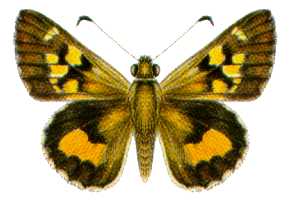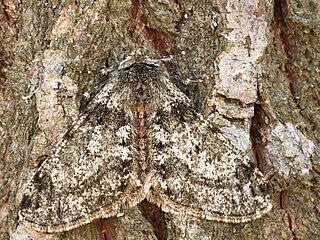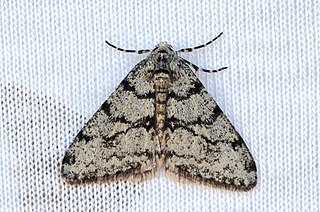
Moths are a group of insects that includes all members of the order Lepidoptera that are not butterflies. They were previously classified as suborder Heterocera, but the group is paraphyletic with respect to butterflies and neither subordinate taxon is used in modern classifications. Moths make up the vast majority of the order. There are approximately 160,000 species of moth, many of which have yet to be described. Most species of moth are nocturnal, although there are also crepuscular and diurnal species.

Crambidae comprises the grass moth family of lepidopterans. They are variable in appearance, with the nominal subfamily Crambinae taking up closely folded postures on grass stems where they are inconspicuous, while other subfamilies include brightly coloured and patterned insects that rest in wing-spread attitudes.

The Pyralidae, commonly called pyralid moths, snout moths or grass moths, are a family of Lepidoptera in the ditrysian superfamily Pyraloidea. In many classifications, the grass moths (Crambidae) are included in the Pyralidae as a subfamily, making the combined group one of the largest families in the Lepidoptera. The latest review by Eugene G. Munroe and Maria Alma Solis retain the Crambidae as a full family of Pyraloidea.

The flannel moths or crinkled flannel moths are a family of insects. They occur in North America and the New World tropics.
Phigalia or Phigaleia or Phigalea, also known as Phialia, was an ancient Greek city in the south-west corner of ancient Arcadia, in the region of ancient Parrhasia close to the frontiers of Messenia, and upon the right bank of the Neda, about halfway between the sources and the mouth of this river. It is also the present name of a nearby modern village, known up to the early 20th century as Pavlitsa (Παύλιτσα). In modern geography it is located in southeastern Elis. It is situated on an elevated rocky site, among some of the highest mountains in the Peloponnese, the most conspicuous being Mt Cotylium and Mt Elaeum; the identification of the latter is uncertain.

The Adelidae or fairy longhorn moths are a family of monotrysian moths in the lepidopteran infraorder Heteroneura. The family was first described by Charles Théophile Bruand d'Uzelle in 1851. Most species have at least partially metallic, patterned coloration and are diurnal, sometimes swarming around the tips of branches with an undulating flight. Others are crepuscular and have a drab coloration. Fairy longhorn moths have a wingspan of 4–28 millimeters, and males often have especially long antennae, 1–3 times as long as the forewing.

Schinia, commonly called flower moths, is a large genus of moths belonging to the family Noctuidae. The genus has a Holarctic distribution with the vast majority of species being found in North America, many with a very restricted range and larval food plant.
The Prix de Flore is a Group 3 flat horse race in France open to thoroughbred fillies and mares aged three years or older. It is run at Saint-Cloud over a distance of 2,100 metres, and it is scheduled to take place each year in late October.

Phigalia titea, the spiny looper or half-wing moth, is a species of moth in the family Geometridae. The species was first described by Pieter Cramer in 1780. The average wingspan is about 34 mm.

Apocheima is a genus of moths in the family Geometridae erected by Jacob Hübner in 1825, also known as Phigalia.

Trapezites phigalia, commonly known as the heath ochre or phigalia skipper, is a species of butterfly in the family Hesperiidae. It is endemic to Australia, where it occurs in New South Wales, Queensland, South Australia and Victoria. It is primarily found in eucalypt woodlands, open forests, and coastal healthland habitats.

Phigalia pilosaria, the pale brindled beauty, is a moth of the family Geometridae. The species was first described by Michael Denis and Ignaz Schiffermüller in 1775. It is found from Europe and Anatolia to the Caucasus.
BugGuide is a website and online community of naturalists, both amateur and professional, who share observations of arthropods such as insects, spiders, and other related creatures. The website consists of informational guide pages and many thousands of photographs of arthropods from the United States and Canada which are used for identification and research. The non-commercial site is hosted by the Iowa State University Department of Entomology. BugGuide was conceived by photographer Troy Bartlett in 2003 and since 2006 has been maintained by John VanDyk, an adjunct assistant professor of entomology and a senior systems analyst at Iowa State University. The website has been recognized for helping change the public perception of insects.

Phigalia owadai is a species of moth of the family Geometridae. It is found in Taiwan.
Arrhichionof Phigalia was a champion pankratiast in the ancient Olympic Games. He died while successfully defending his championship in the pankration at the 54th Olympiad. Arrhichion has been described as "the most famous of all pankratiasts".

Apocheima strigataria, the small phigalia moth, is a moth of the family Geometridae. The species was first described by Charles Sedgwick Minot in 1869. It is found in North America, where it has been recorded from North Dakota to Texas and further east. The habitat consists of woodlands and forests.

Phigalia plumogeraria, the walnut spanworm moth, is a species of geometrid moth in the family Geometridae.

A MONA number, or Hodges number after Ronald W. Hodges, is part of a numbering system for North American moths found north of Mexico in the Continental United States and Canada, as well as the island of Greenland. Introduced in 1983 by Hodges through the publication of Check List of the Lepidoptera of America North of Mexico, the system began an ongoing numeration process in order to compile a list of the over 12,000 moths of North America north of Mexico. The system numbers moths within the same family close together for identification purposes. For example, the species Epimartyria auricrinella begins the numbering system at 0001 while Epimartyria pardella is numbered 0002.














